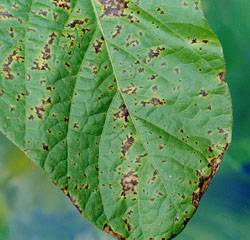Horticultural crops :: Vegetables:: Beans
Bacterial Blights: Xanthomonas campestris pv phaseoli
Symptoms
-
There are two widespread bacterial blights that affect most types of beans, common blight ( Xanthomonas campestris pv phaseoli) and halo blight ( Pseudomonas syringae pathovar phaseolicola).
-
The stems, leaves and fruits of bean plants can be infected by either disease. Rain and damp weather favor disease development.
-
Halo blight occurs primarily when temperatures are cool.
-
Light greenish-yellow circles that look like halos form around a brown spot or lesion on the plant. With age, the lesions may join together as the leaf turns yellow and slowly dies. Stem lesions appear as long, reddish spots.
-
Leaves infected with common blight turn brown and drop quickly from the plant.
-
Common blight infected pods do not have the greenish-yellow halo around the infected spot or lesion. Common blight occurs mostly during warm weather.
Management
-
Both of these diseases come from infected seeds. The diseases spread readily when moisture is present.
-
Avoid overhead watering and do not touch plants when the foliage is wet. The bacteria can live in the soil for two years on plant debris.
-
Do not plant beans in the same location more frequently than every third year. Buy new seeds each year.
-
Fixed copper can be applied at ten day intervals. Wait one day between spraying and harvest.
|
|
|

